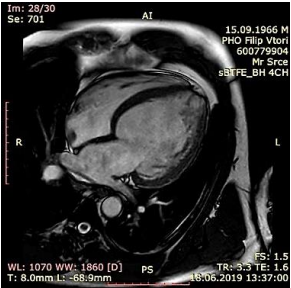Rare case of super-response to Cardiac Resynchronization Therapy in Macedonian patient with Dilated Left Ventricular Non-Compaction Cardiomyopathy

Submission to VIJ 2024-02-24
Keywords
- Cardiac resynchronization therapy (CRT),
- Left ventricular non-compaction (LVNC),
- Heart failure (HF),
- dilated cardiomyopathy (DCM)
Copyright (c) 2024 Bozhin Shopov, Planinka Zafirovska, Jorgo Kostov, Nikola Manev, Antonio Georgiev

This work is licensed under a Creative Commons Attribution 4.0 International License.
Abstract
Background: Left ventricular non-compaction (LVNC) is rare cardiomyopathy with increased and prominent endomyocardial trabeculations also known as spongy myocardium. It is often found in association with a dilated cardiomyopathy (DCM) and has high incidence of Heart failure (HF). Cardiac resynchronization therapy (CRT) is currently recommended by the available guidelines for selected patients with Heart failure with reduced ejection fraction (HFrEF).
Aim: Our case report aims to highlight the therapeutic benefits and superresponse to CRT in a patient with Left ventricular non-compaction cardiomyopathy and HFrEF.
Case report: 55-year-old Macedonian male patient with HFrEF, Left bundle branch block (LBBB) remained symptomatic (NYHA III) despite optimal medical treatment (OMT). Echocardiography and CMR findings were in addition to dilated and left ventricular non-compaction cardiomyopathy. Cardiac resynchronization therapy was indicated and 18 months after implantation of CRT-P device we have achieved complete and utter reversibility of systolic myocardial function (EF from 23% to 53%), left ventricular internal diameter was reduced from 90mm to 64mm, left ventricular end systolic volume (LVESV) was reduced from 319ml to 98ml and patient quality of life significantly improved.
Conclusion: Cardiac resynchronization therapy is a safe and valuable method of treatment for patients with HFrEF due to dilated left ventricular non-compaction cardiomyopathy.
References
- Peix A, Padrón K, Cabrera LO, et al. Intraventricular synchronism assessment by gated-SPECT myocardial perfusion imaging in cardiac resynchronization therapy. Does cardiomyopathy type influence results? EJNMMI Research. 2020;10(1). doi:10.1186/s13550-020-00703-4
- Choi Y, Kim SM, Lee SC, Chang SA, Jang SY, Choe YH. Quantification of Left ventricular trabeculae using cardiovascular magnetic resonance for the diagnosis of Left ventricular noncompaction: Evaluation of trabecular volume and refined semi-quantitative criteria. Journal of Cardiovascular Magnetic Resonance. 2016;18(1):1-13. doi:10.1186/s12968-016-0245-2
- Hoshiba Y, Sugimoto A, Doi S, et al. Discontinuation of cardiac resynchronization therapy for heart failure due to dilated cardiomyopathy in a 61-year-old female “ super-responder” with return of a reduced left ventricular ejection fraction to normal. American Journal of Case Reports. 2020;21:1-5. doi:10.12659/AJCR.926704
- McDonagh TA, Metra M, Adamo M, et al. 2021 ESC Guidelines for the diagnosis and treatment of acute and chronic heart failure. European Heart Journal. 2021;42(36):3599-3726. doi:10.1093/eurheartj/ehab368
- Glikson M, Nielsen JC, Kronborg MB, et al. 2021 ESC Guidelines on cardiac pacing and cardiac resynchronization therapy. European Heart Journal. 2021;42(35):3427-3520. doi:10.1093/eurheartj/ehab364
- Normand C, Linde C, Bogale N, et al. Cardiac resynchronization therapy pacemaker or cardiac resynchronization therapy defibrillator: What determines the choice? - Findings from the ESC CRT survey II. Europace. 2019;21(6):918-927. doi:10.1093/europace/euz002
- Steffel J, Ruschitzka F. Superresponse to cardiac resynchronization therapy. Circulation. 2014;130(1):87-90. doi:10.1161/CIRCULATIONAHA.113.006124
- Peix A, Karthikeyan G, Massardo T, et al. Value of intraventricular dyssynchrony assessment by gated-SPECT myocardial perfusion imaging in the management of heart failure patients undergoing cardiac resynchronization therapy (VISION-CRT). Journal of Nuclear Cardiology. 2021;28(1):55-64. doi:10.1007/s12350-018-01589-5
- Erdmann E, Freemantle N, Ph D, Gras D, Kappenberger L, Tavazzi L. The effect of cardiac resynchronization on morbidity and mortality in heart failure: Comments. Indian Heart Journal. 2005;57(2):186. doi:10.1111/j.1527-5299.2005.04176.x
- Ghio S, Freemantle N, Scelsi L, et al. Long-term left ventricular reverse remodelling with cardiac resynchronization therapy: Results from the CARE-HF trial. European Journal of Heart Failure. 2009;11(5):480-488. doi:10.1093/eurjhf/hfp034
- Dickstein K, Normand C, Auricchio A, et al. CRT Survey II: a European Society of Cardiology survey of cardiac resynchronisation therapy in 11 088 patients—who is doing what to whom and how? European Journal of Heart Failure. 2018;20(6):1039-1051. doi:10.1002/ejhf.1142
- Taborsky M, Skala T, Aiglova R, et al. Cardiac Resynchronization and Defibrillator Therapy (CRT-D) or CRT Alone (CRT-P) in patients with dilated cardiomyopathy and heart failure without late gadolinium enhancement (LGE) cardiac magnetic resonance imaging (CMRI) high-risk markers - CRT-REALITY . Biomedical Papers. 2021;(Icd). doi:10.5507/bp.2021.015
- Towbin JA, Lorts A, Jefferies JL. Left ventricular non-compaction cardiomyopathy. The Lancet. 2015;386(9995):813-825. doi:10.1016/S0140-6736(14)61282-4
- Qiu Q, Chen Y, Mai J, et al. Effects of cardiac resynchronization therapy on left ventricular remodeling and dyssynchrony in patients with left ventricular noncompaction and heart failure. The international journal of cardiovascular imaging. 2015;31(2):329-337. doi:10.1007/s10554-014-0568-8
- Oginosawa Y, Nogami A, Soejima K, et al. Effect of Cardiac Resynchronization Therapy in Isolated Ventricular Noncompaction in Adults: Follow-Up of Four Cases. Journal of cardiovascular electrophysiology. 2008;19:935-938. doi:10.1111/j.1540-8167.2008.01161.x
